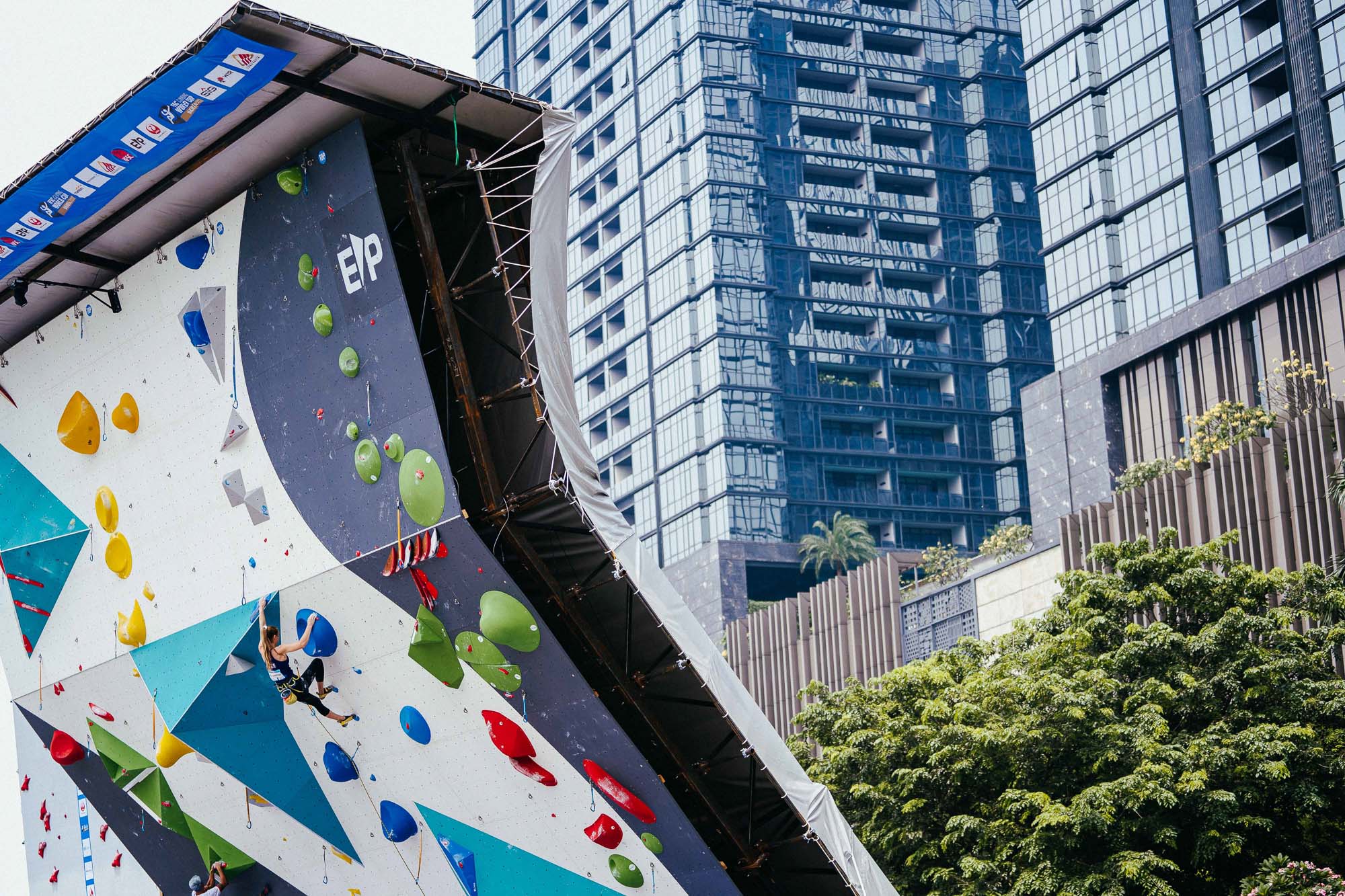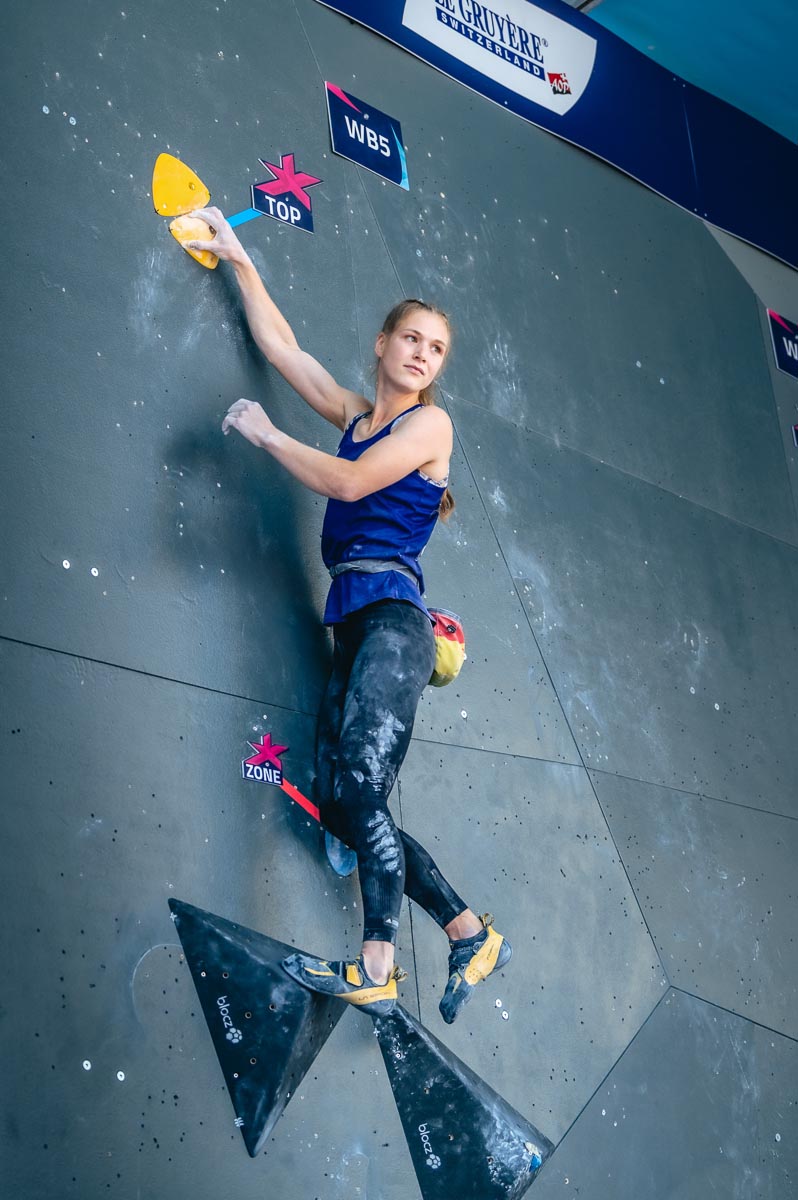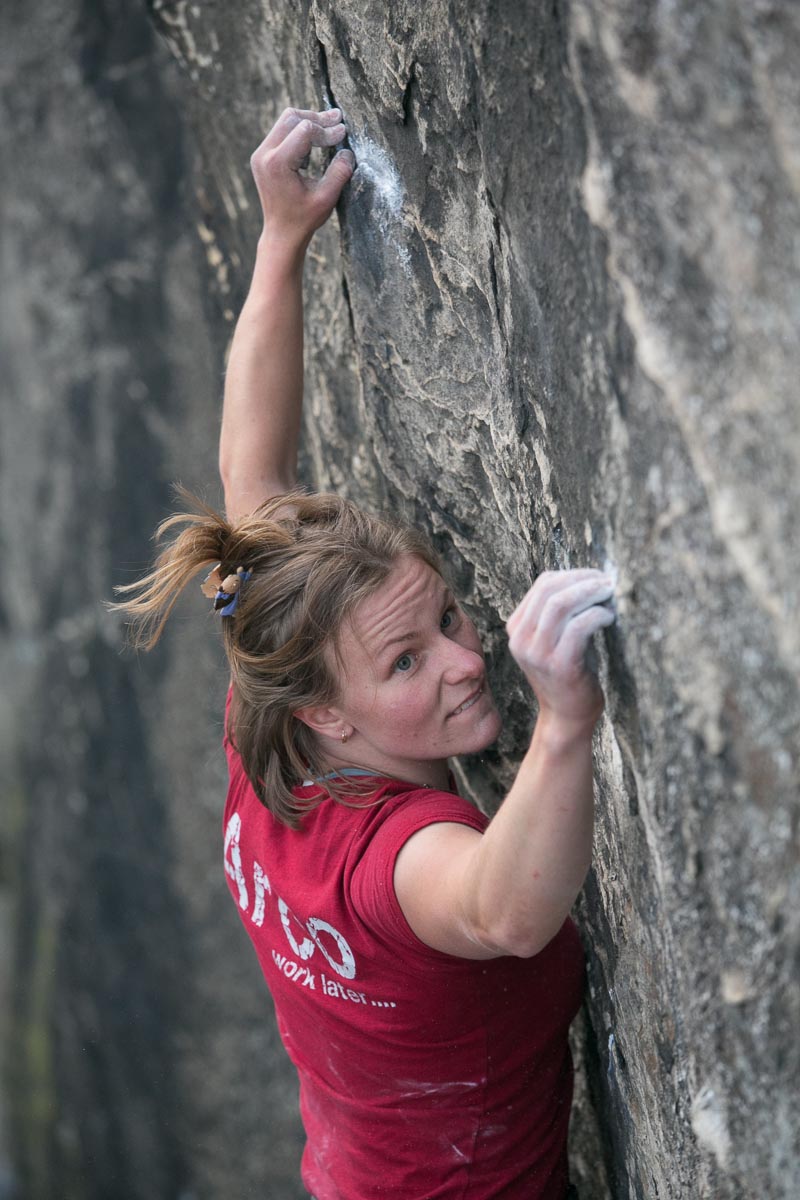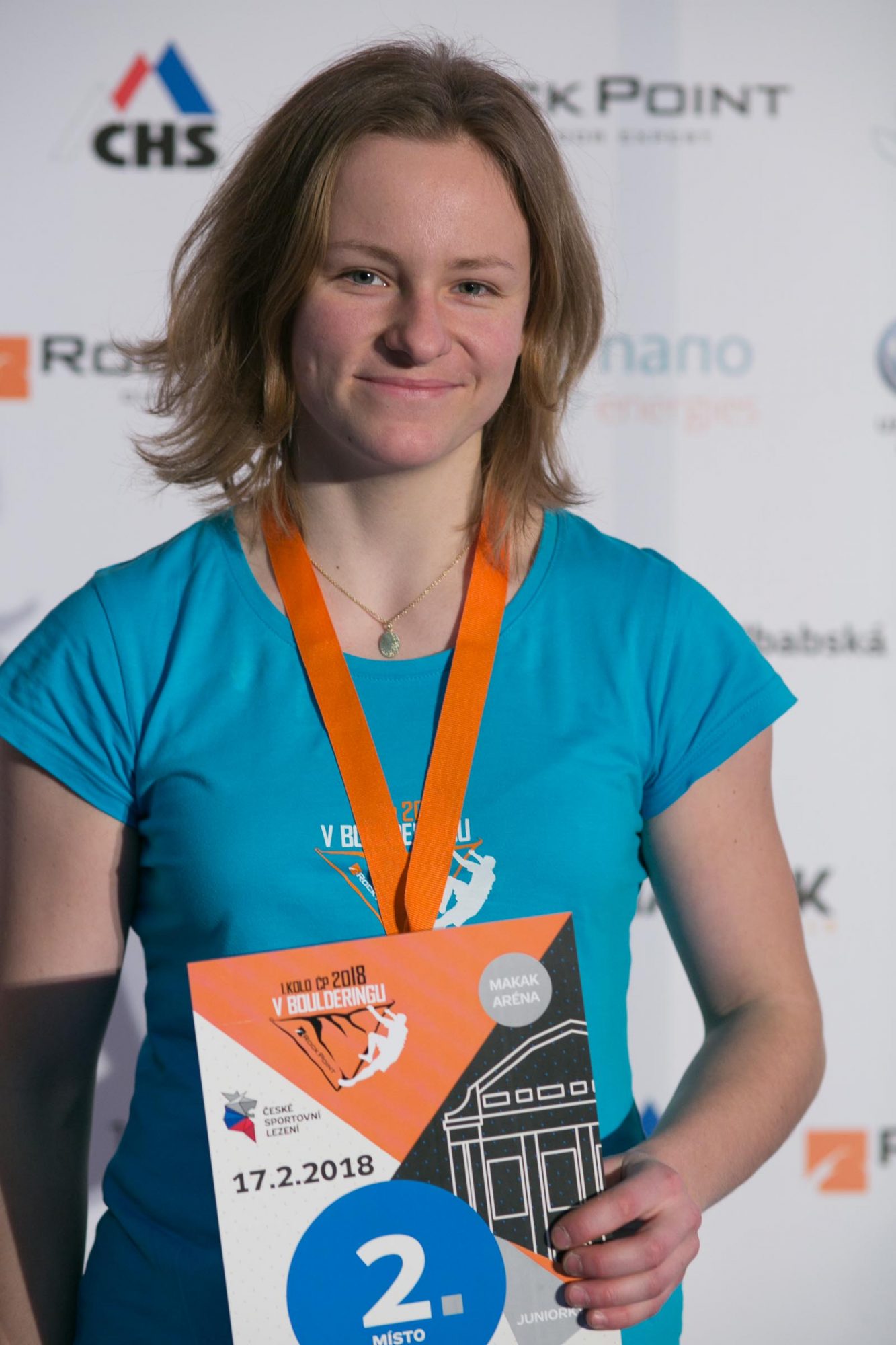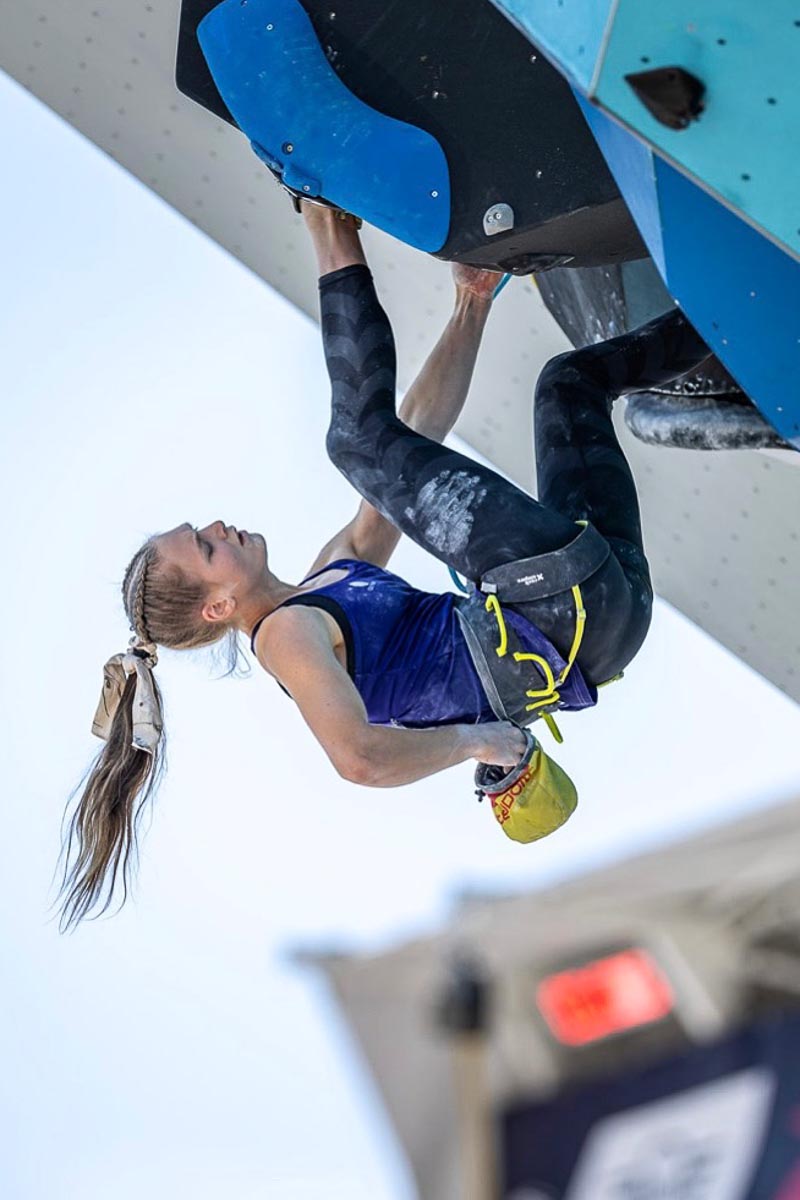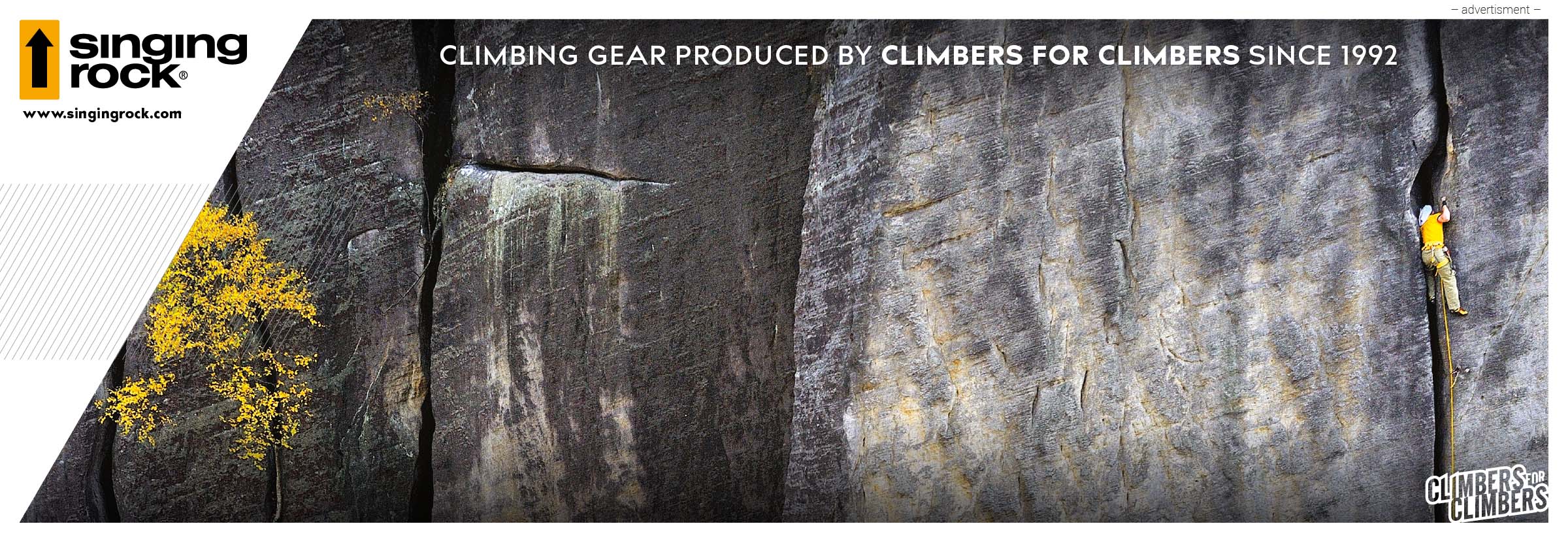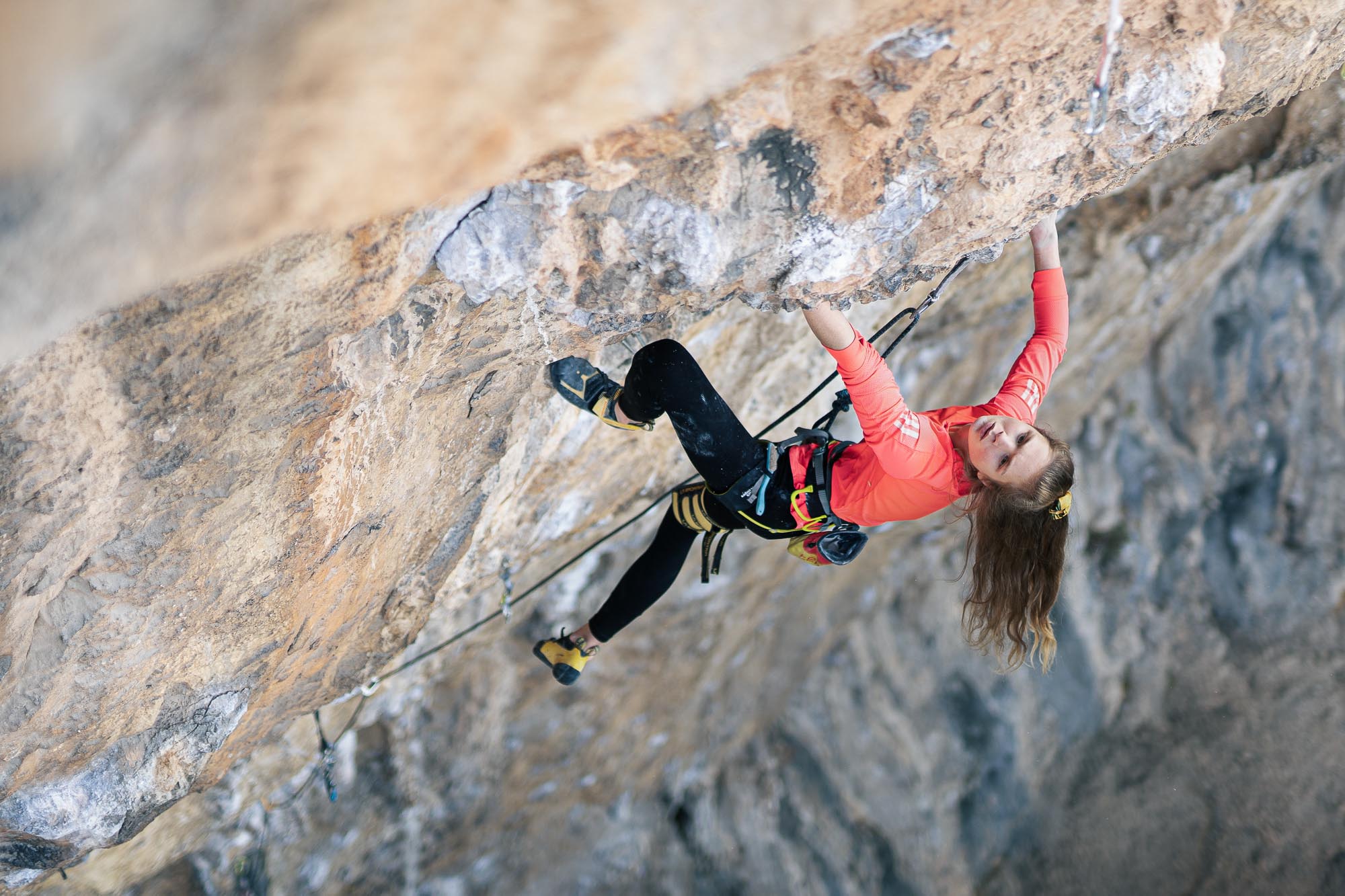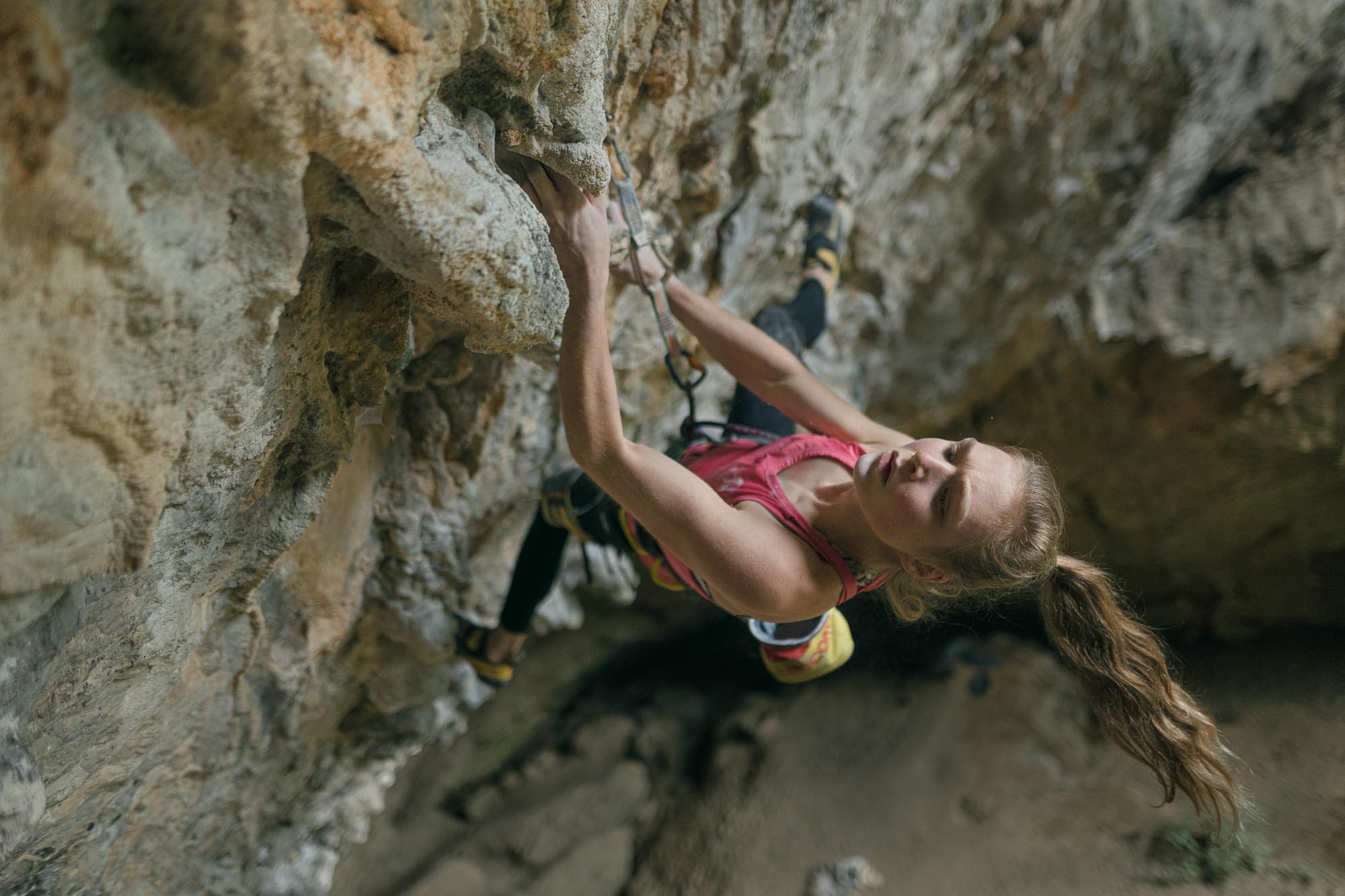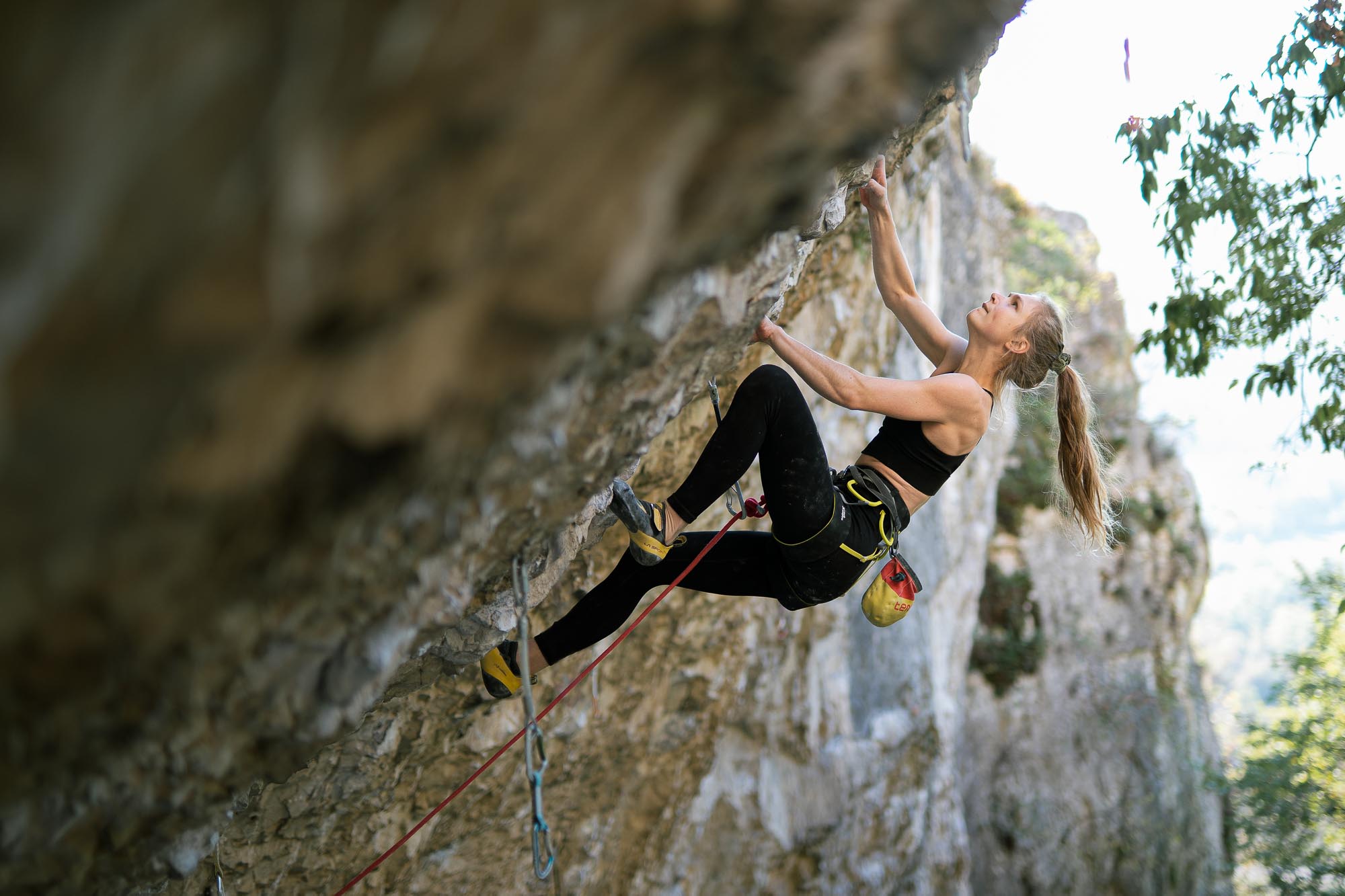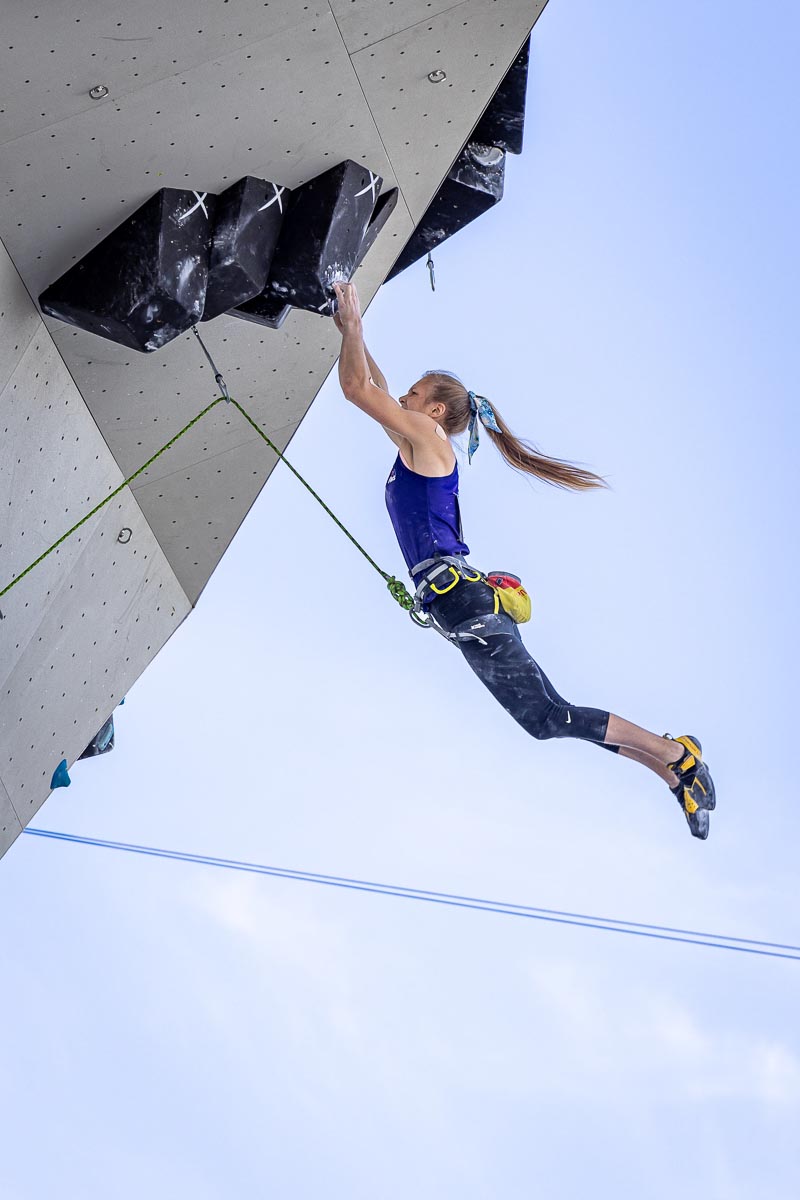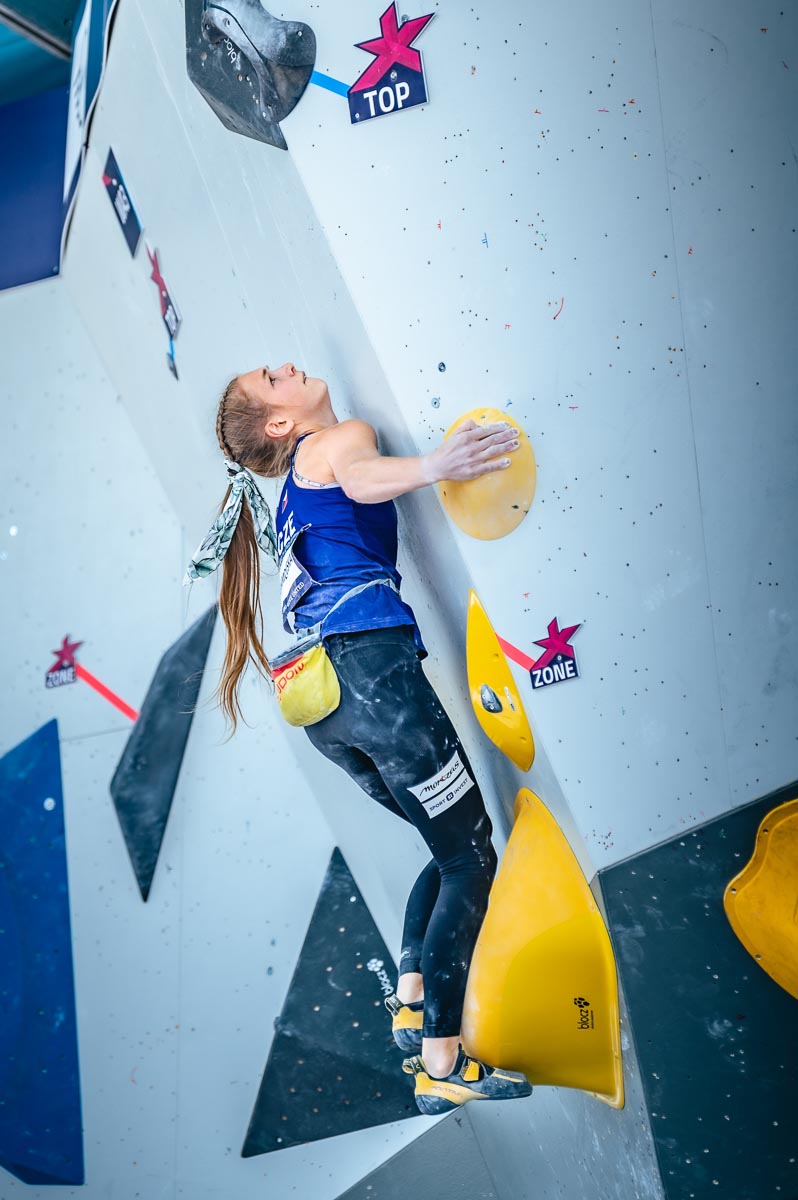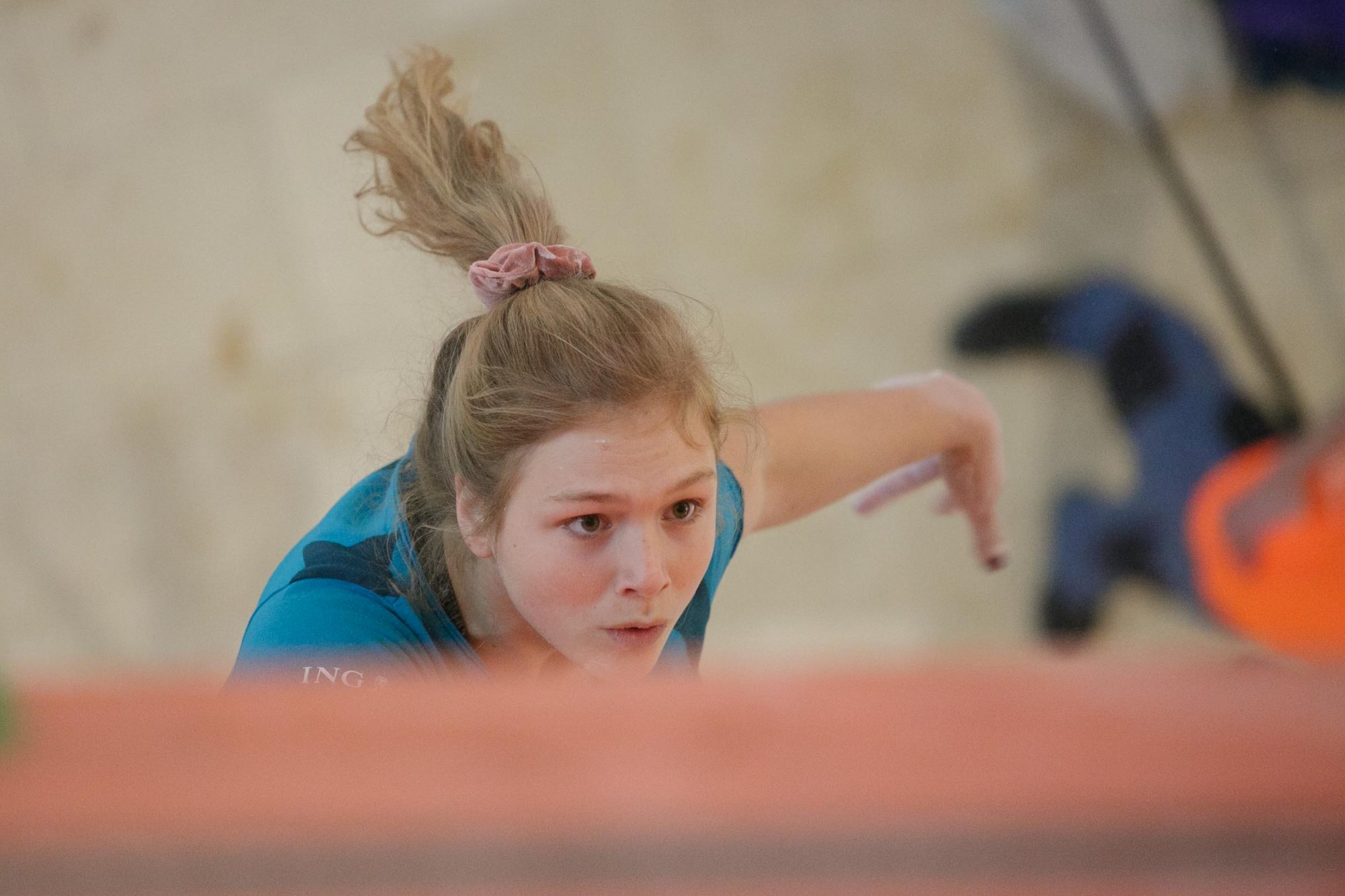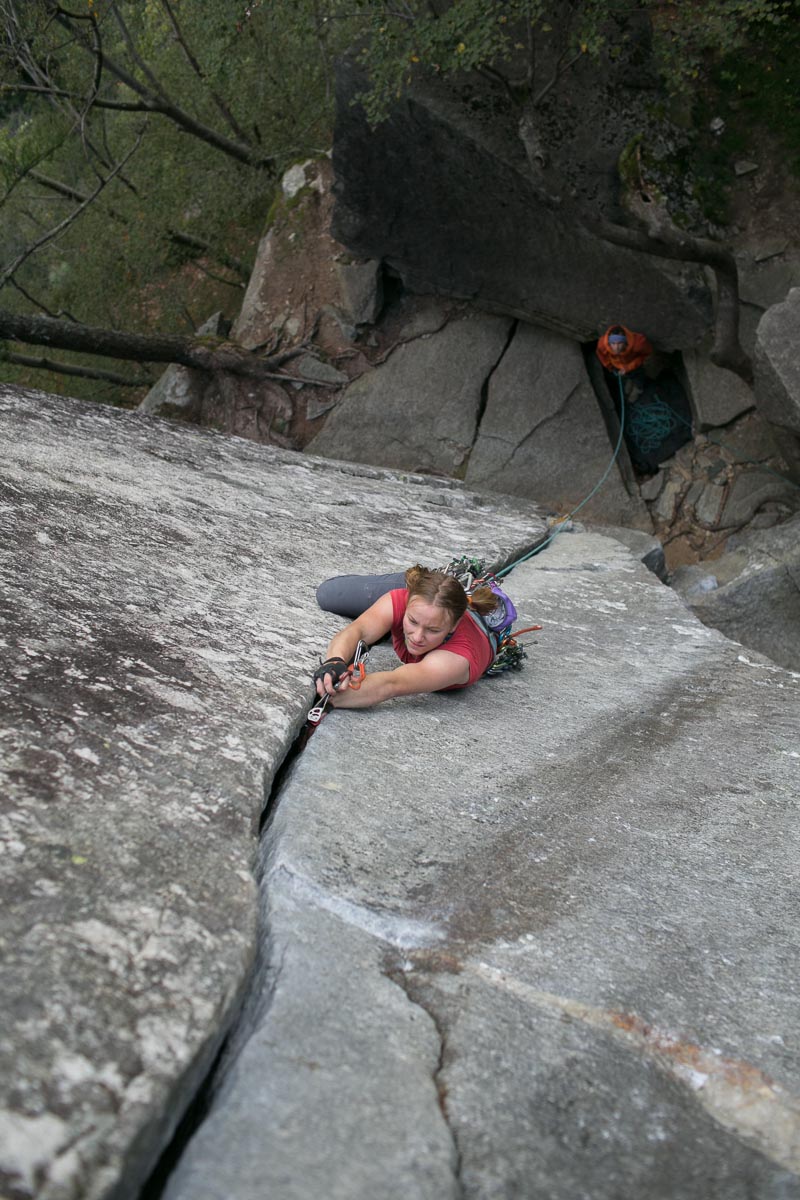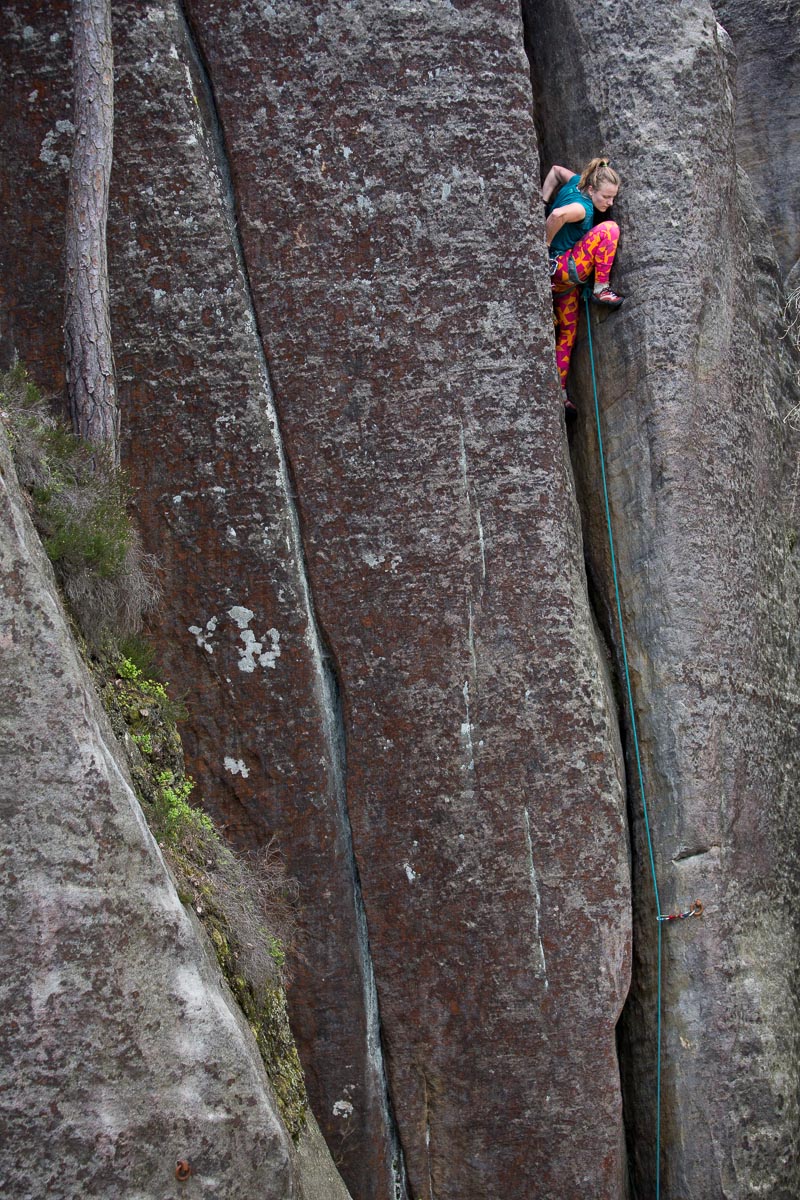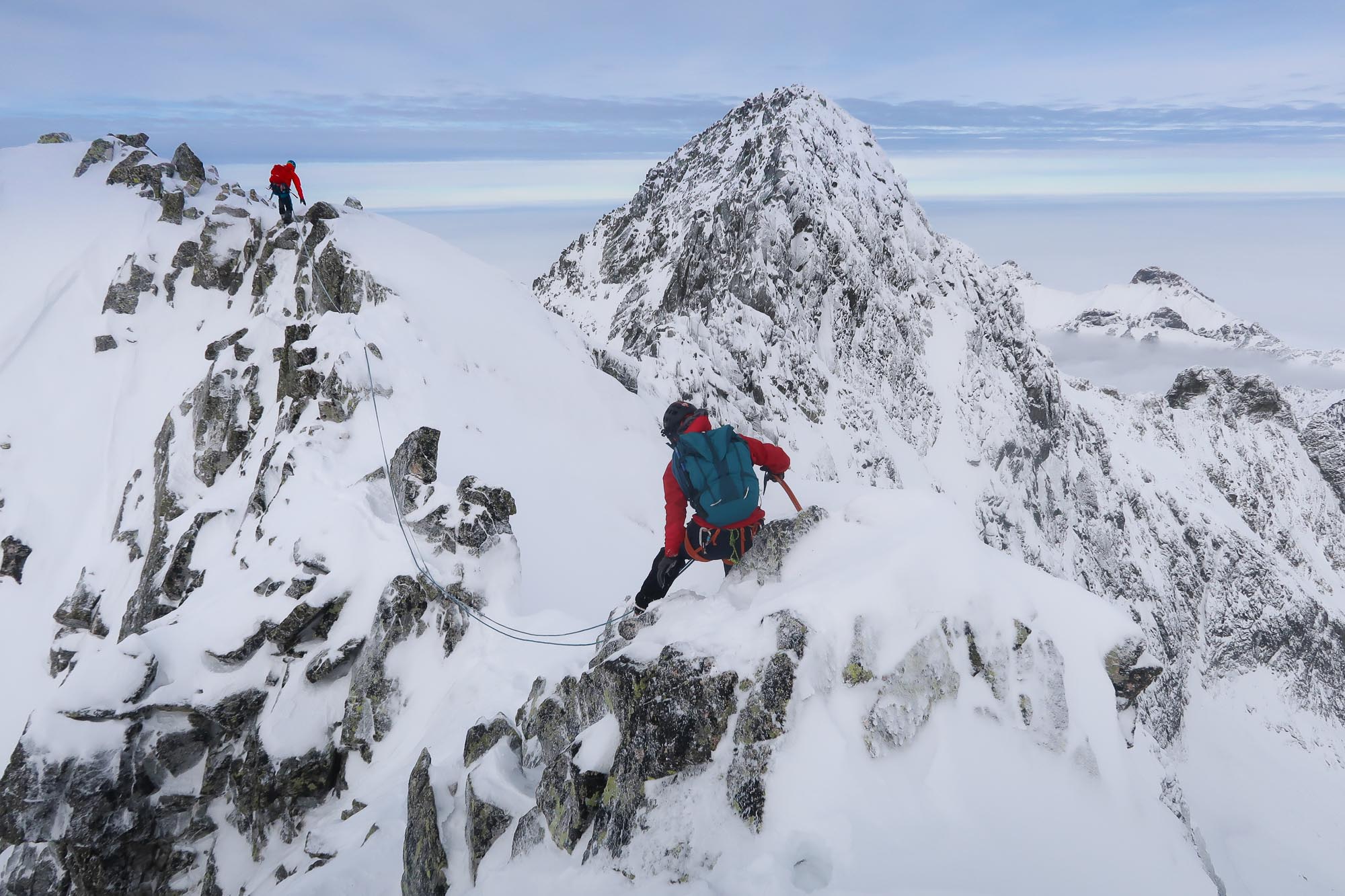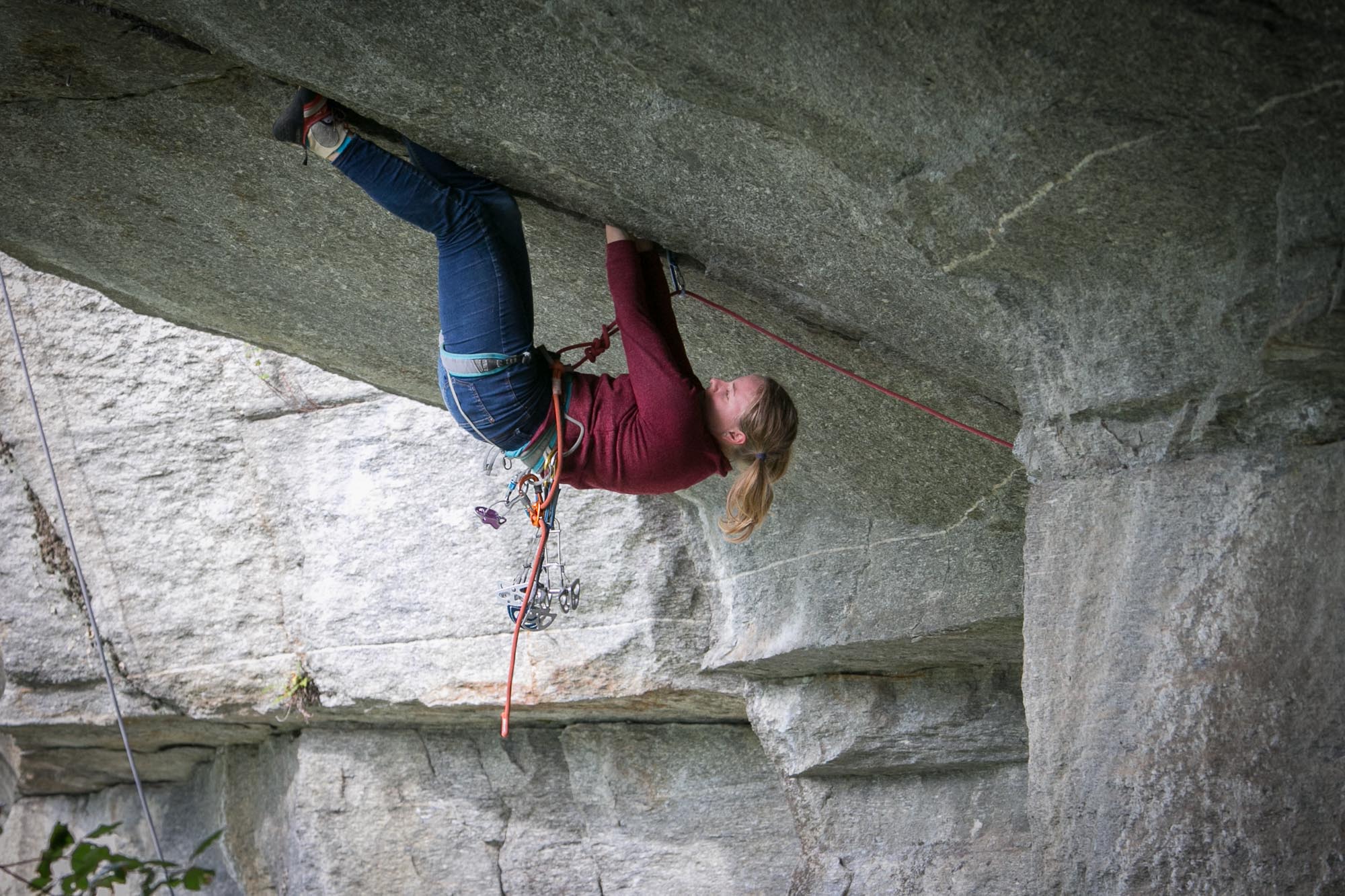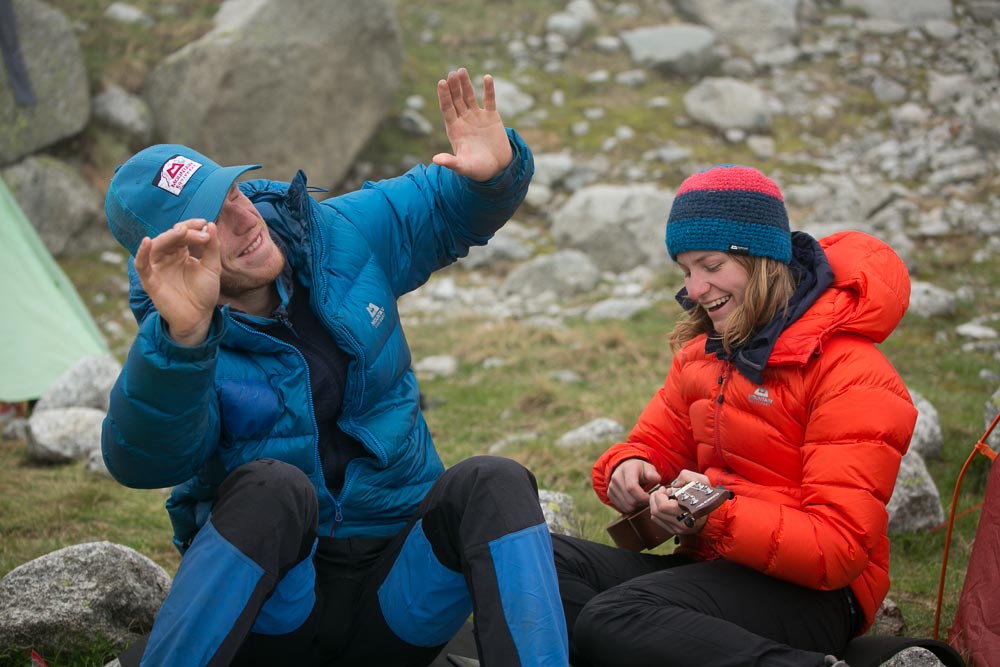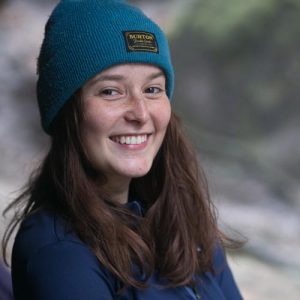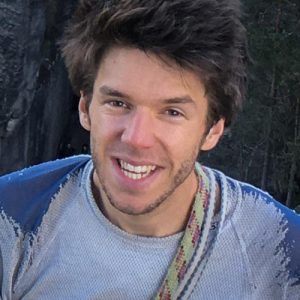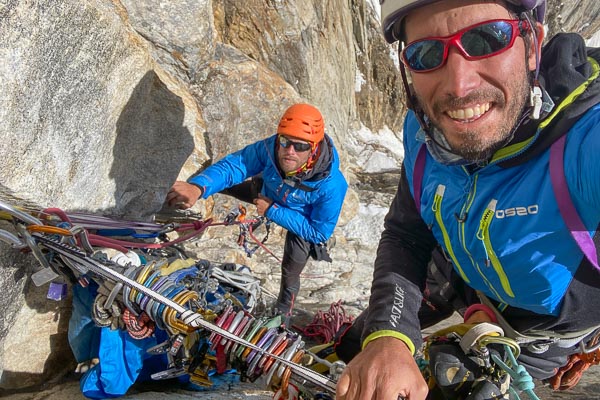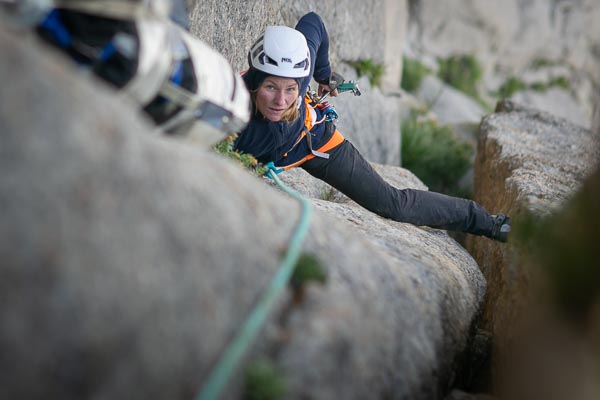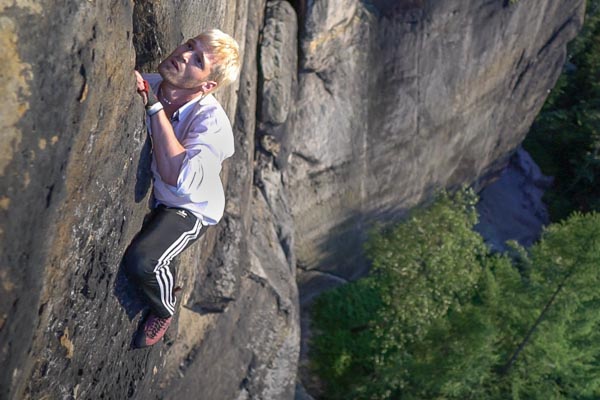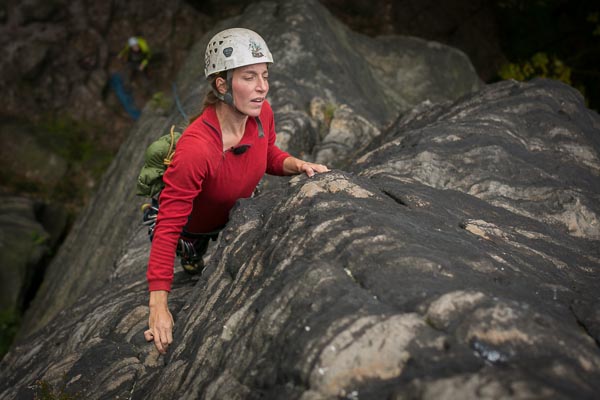ANČA AND ELLA
One is waiting for an expedition to Pakistan, the other is training for the Olympics in Paris. Anička Šebestíková and Eliška Adamovská are united by their high commitment to the same sport. And yet they have completely different lifestyles…
SAME SPORT, DIFFERENT LIFE
Doing a joint interview with such prominent girls of Czech climbing sounded good. On one side of the table was the Czech National Team lead specialist, the sport climber Eliška Adamovská who has climbed up to 8c+/9a, on the other side was the fearless lover of cracks, off-widths, and the first Czech woman to climb 8a trad, Anča Šebestíková. For a moment I was lulled by the idea that the girls would share many milestones of their lives. But after the first few minutes it was clear that each climbing discipline brought with it a different lifestyle and world view.
They both share a love for climbing, rocks and nature. It just means something a little different for each. Eliška started climbing early in her childhood and gradually moved from rocks to the world of colorful holds and competitive drills. Anička got into climbing in her teens and tried the opposite approach. Eventually she chased away her competition cravings and took to the sandstones with a bunch of friends. Since then, the girls have a fair chunk of their climbing lives has passed.
Coordinating our schedules so that all three of us could meet wasn’t easy. Anča lives in Prague, Eliška and I in Brno, and we needed to fit in one day when neither of us would be abroad. We first talked about the interview at the beginning of January. We agreed on a specific date in February and met in March. Anička was travelling from Nový Jičín to Prague then, so she made a stop halfway. We met in a run-down café near the Faculty of Arts of Masaryk University, where Eliška came running to us in a quick break between her trainings.
“Girls, do you even know each other?”
“Well, not really… I guess we saw each other somewhere.“
We didn’t have time for more introductions — we got straight to business.
RANGE OF MOVES
I’ll start with you, Anča. Most climbers will associate you with fearlessly climbing cracks that no man would venture into. Are you scared when you are climbing?
Anča: I’m scared all the time, but not in cracks. Crack climbing is easy in that you learn a range of moves and then you just apply them. It is unlike wall climbing where things are always changing. If you trust a body part to stay in the crack, you won’t fall out. Which isn’t really applicable in face climbing — there’s a lot of external influences.
How’s your sandstone climbing, Eliška?
Eliška: I climbed on sandstone a couple of times in Tisá. I really admire people who climb there. I used to have a problem with my skin, and that’s why we didn’t go there. My hands were sweating so much that it was almost impossible to climb on limestone, let alone sand. And then when my climbing became competitive, there was no time to get on the sandstones. I guess that’s a stupid excuse. I don’t have much confidence in sandstone climbing either. It seems to me the lifestyle is vastly different from ours. More free. It might hurt me to get to know it better, because I can’t live like that right now.
Eliška: „It might hurt me to get to know the sandstone lifestyle better, because I can’t live like that right now.”
You mention different lifestyles. That reminds me, Anča used to compete.
A: I did it for about a year.
Why did you give up this discipline?
A: There were several reasons. I struggled terribly with my head every time I competed, and I really wasn’t good at lead climbing. I was falling, and it was very frustrating. I didn’t have much motivation to improve because I had been climbing for a relatively short time and I didn’t have a relationship with the sport yet. At the same time, I started meeting people who were taking me out on rock. So I finally got into it. The second reason was inflammation in my hands. Before competing, for perhaps the first and last time in my life, I trained purposefully for six months. I didn’t have any know-how — just some written out information about training. So I was destroying myself on the wall in Austria several times a day, I guess I had nothing else to do. (laughs) And the hands weren’t really good from that.
When you say you were struggling with your head, what was that all about?
A: Somehow, I wasn’t able to climb well during the comps. I fell off the second hold at the only World Cup I’ve attended.
E: It’s hard. I’ve actually managed to climb my absolute maximum in competitions maybe three times in my life. You do everything you can to perform, but eventually you get thrown off by something stupid in the isolation zone. I find that the older I get, the more stressed I get. I’ve climbed a billion miles. I wouldn’t make a mistake on a rock climb. But at a stressful comp, I’d misread the route and make that mistake. It’s a mindset thing. That’s why you have to have trained a lot more than what you climb during a sharp attempt.
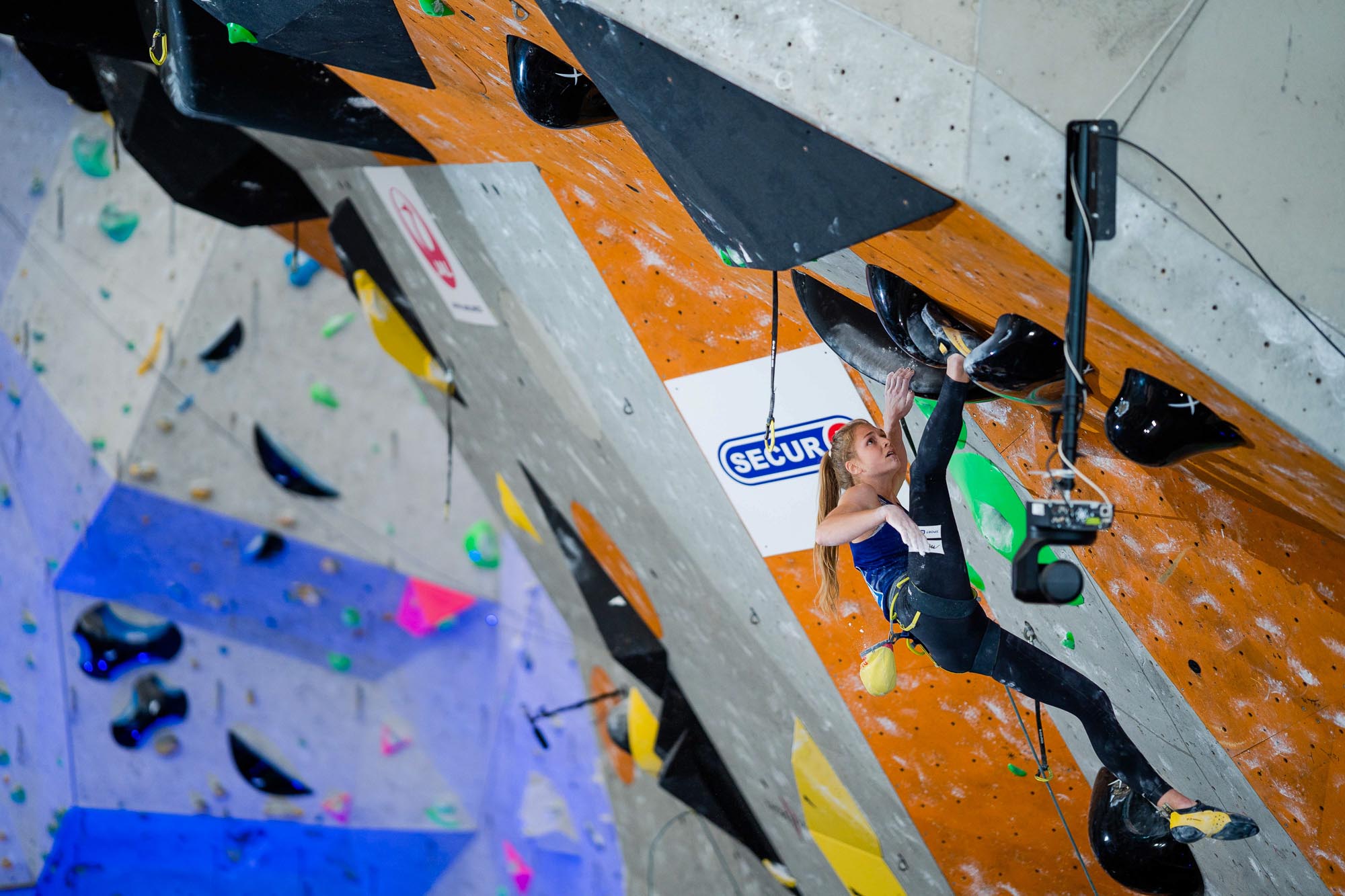
A STRUCTURED TRAINING AND LIFE
How has your year been so far, Eliška?
E: I’m following my training plan and my season has just started (the article was written in March this year, ed.). Now there were some nominations that I didn’t have to go through because I had an automatic nomination. I originally wanted to attend, but my coach and I ended up changing our minds. Together we decided to participate in one nomination event, which will combine bouldering and lead climbing. We want to include a maximum of twelve competitions in this season, not twenty like last year. That was an awful lot. The main priority this year is preparing for the Olympics and my university responsibilities.
Can you describe your training?
E: I’m having a recovery week right now, so I’m not doing much. I usually train three times a day, but every day is different. The base includes one climb, one campus and one workout. Sometimes I have two climbing workouts instead of one workout — it varies a bit.
How do you juggle that with university?
E: Not really, because there are other sports I have to take. That’s a bit of a pain, although now in my third year I don’t have as many. I enjoyed the theory classes a lot. Anyway, my major is not the direction I want to go in. If I were to train people, I’d rather draw on my own experience and the information that can be gained directly from climbing.
How would you describe your current lifestyle?
E: It’s quite structured. Even if I didn’t climb, I’d have to destroy myself with something else during the day. I need to completely exhaust myself to be happy with myself. I can’t relax. I enjoy what I’m doing, but sometimes I wonder if I’d have more fun just climbing at Kotelna (a bouldering site in Brno, note by the author). I still want to give it my best for the next few years. And at the same time I feel that it’s killing me, probably like everyone else. Even though it’s not talked about much, it’s true.
PREPARING FOR PAKISTAN
How are you this year, Annie?
A: I’m pretty free this year. Last year I spent one semester at Erasmus and then completed all my courses in the spring. So now I have half a year off just to write my bachelor’s thesis. I’m trying to get away as much as possible. Other than that, I’ve had a bit of a rough time. Last year, I mostly focused on university because of my injured knee. Then I tried to get over it. And now I’m trying to adapt my climbing to the Sokolíci (a team of young mountaineers of the Czech Mountaineering Society) trip to Pakistan in August.
Could you tell us a little bit about the trip?
A: We are currently putting together a plan. We agreed that we will go to Nangma Valley, where the most famous big wall of Amin Brakk is and above it there are countless snow-covered mountains. I’d like to do a bit of alpinism there and see some medium-sized mountains, and also climb some rock from base camp on Zang Brakk — that’s a smaller wall, about 500 metres. It looks pretty real.
E: Only five hundred… (laughs)
A: So this Amin Brakk is fifteen hundred meters, El Cap style. Only Franta Bulicka would dare to go up there. He’s looking for partners.
So now your goal is to strengthen your knee to withstand the planned expedition. Do you have specific training for that?
A: I was talking about training with some friends. Like Sima, who has a lot of orienteering experience. In the end, we came up with the idea that it would be best to train climbing and gain volume. I still have to take into account my injured knee, one leg is still much smaller than the other. The physio advised me to sort out the knee first and then start training. So I don’t have any special training yet.
E: The physio is important…
A: But it’s costing money… (laughs) Going back to the goals — I think for mine, I actually just need to be really good at climbing outside.
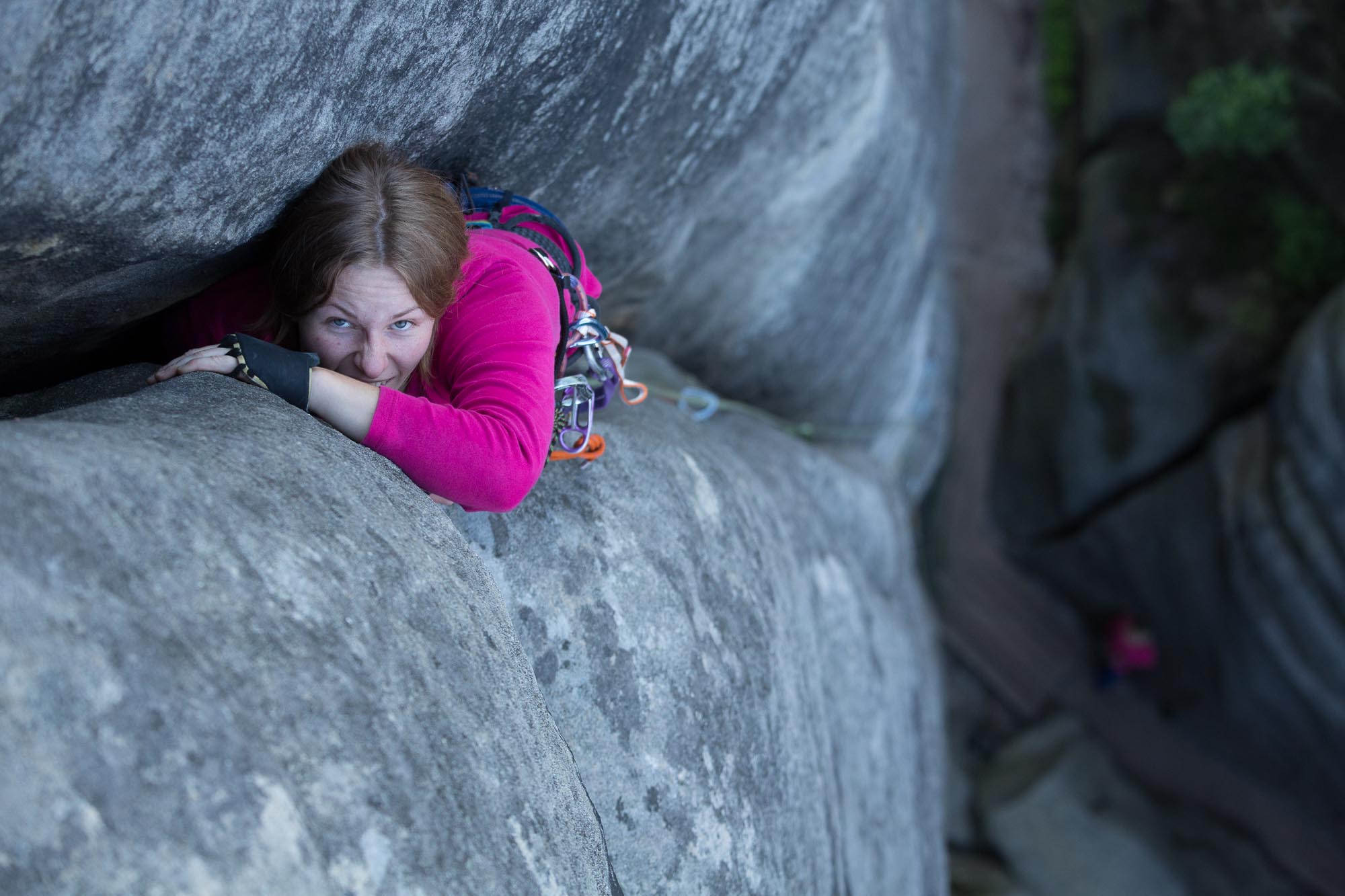
A FACE FOR SALE?
Is it possible to make a living by climbing?
E: I do it for a living now.
A: I think I’m definitely not at a level where it makes sense to make a living by climbing. In the Czech Republic, you don’t have a chance to make a living in this sport outside of competitive climbing.
E: Unless you just make a fool of yourself…
A: …unless you’re Mara Holecek. (Czech mountaineer, ed. notice)
E: You can do different ads on Instagram or Facebook. I could do that, but I don’t like it either.
That’s what I wanted to ask you. What do you think about arranging promotional materials, getting sponsors and taking pictures so you can do your sport?
E: Either you have to suck it up and make yourself a walking advertisement, or you just don’t have the money. Because you can’t work and train at the same time.
A: Right now I’m trying to find some middle ground. For example, the gear for high mountains is very expensive. It’s annoying, but I know I need the stuff. I’m trying to negotiate terms with certain brands that would work for both parties. Anyway, I can’t imagine making a living like this in the future.
If you were planning your own expedition, would you be able to get any funding for it? Or would you only be able to get equipment?
A: I am still in the gear phase. With the money it would be more about cooperation with some “non-climbing” companies. Sometimes it happens by chance — a sponsor comes and gives you money because he likes your idea.
E: Or you approach someone directly, but that’s annoying.
A: Exactly.
E: You don’t want to do that. Realistically, there are plenty of companies that would support you. I could raise a lot of money if I wanted to. But I’d have to make, like, a post every day about a cause I don’t believe in. You really don’t want to be associated with anything. Personally, I’m not comfortable selling my own face.
That’s not what you’re asked to do in sport climbing, is it?
E: I’m very lucky to be an employee of Olymp. If I were financially dependent on a brand, I would have to do a lot more. As it is, I only have a few small collaborations — like with a café I really like.
EXCHANGE STAY
Which route from your climbing discipline would you recommend to each other?
E: I would recommend all routes in Rodellar up to 8b. They are really beautiful there. A plenty of knee-bars, it’s divine. Totally different vibe. You can climb there in about thirty sectors facing all directions. You’d like it there.
Do you have a particular route in mind?
E: I would recommend the route called “Mal del Amores”. It’s a nice 8a+, almost forty meters. It runs just a short distance from that famous rock window that looks like a dolphin. That dolphin is also worth climbing, it goes at 7c+. You can see the whole canyon through it, and the breeze blows through it nicely. You’d climb right up.
Eli, have you ever tried any multipitch climbing?
E: I’ve tried a multipitch once or twice in my life, but overall I have to say goodbye to that type of climbing. I suffer from Raynaud’s syndrome and my toes don’t get enough oxygen. Climbing in Spain in more extreme conditions, like minus two degrees, is not for me. I can’t even climb in the cold at Kotelna. It’s twelve degrees there and I have to constantly take off my climbing shoes and put my toes on the heater. When the blood circulation in my feet slows down, blisters start to form, and I can’t even get my climbing shows on. So I’m always watching it, and it’s very restrictive. It also means that if I want to climb a harder route, I can’t do it when it is in condition. I have to be stronger to climb it in warm weather. So mountains are probably not for me unless I want to get frostbite.
What route would you recommend for Eliška?
E: A crack! I can’t climb those at all. Do you know how I climb cracks?
A: A gynecologist-style, right? That’s the best. (Laughs) I’d recommend some trips to Dvorska tower in Adršpach, it’s great. Like “The Neverending Story” IXb. (7a fr.) That’s going to be easy for you, but it’s a beautiful and well-armed climb. Then there’s “Eugene’s America” Xa (7c fr.) by Prcas in Tisá. There, you have to move from the arete to the face. It’s a nice endurance route.
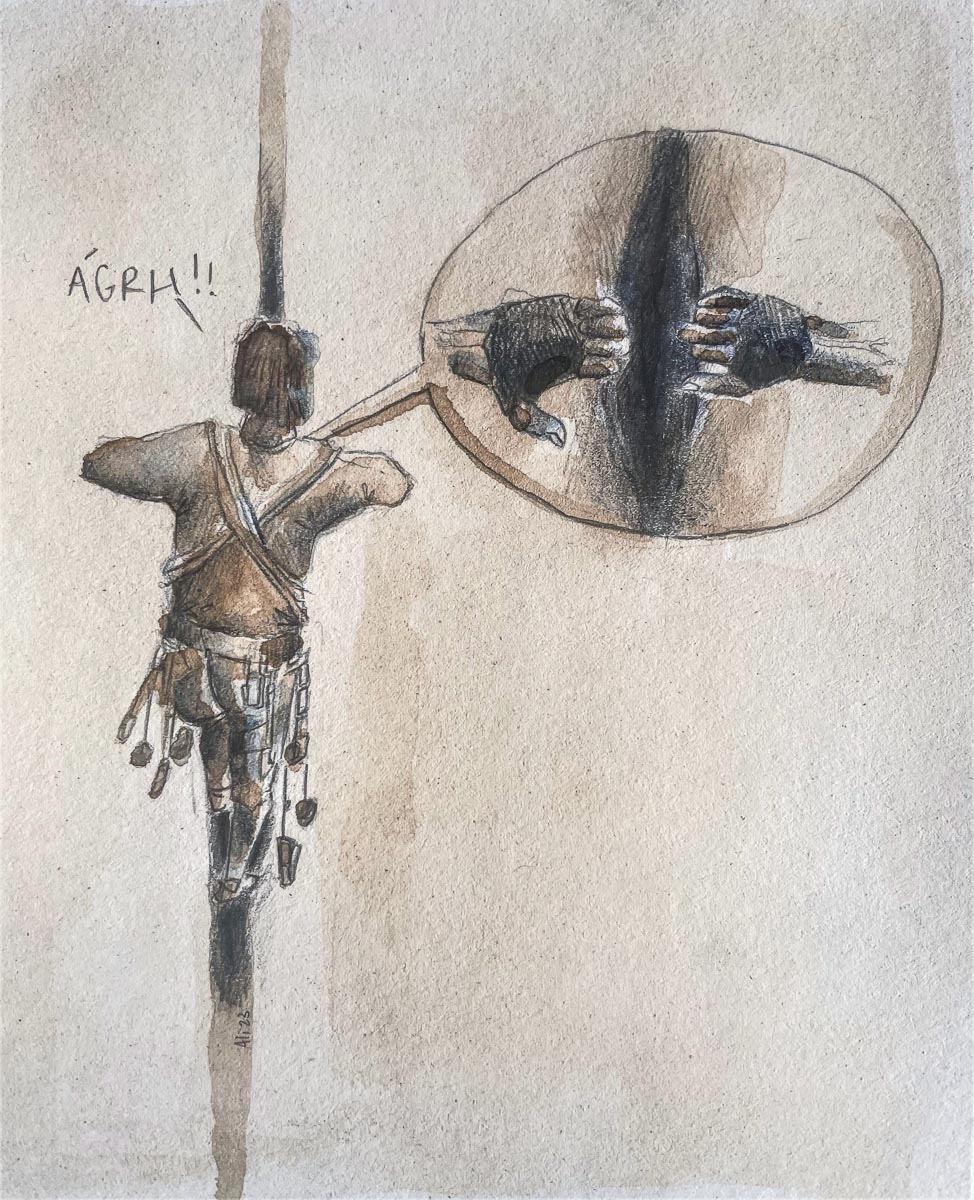
IN THE INTERVIEWER’S SKIN
To conclude, we’ll switch roles. Now, each of you is a journalist and you can ask each other questions. What would you like to know?
E: I’d be interested to know if you feel a sense of freedom when you’re on a big wall, with a group, when you’re not stressed out from competing. Does it make your climbing more free?
A: Of course it’s a process, I have to give it more time. When I climb a single pitch sport route, I give it a shot and I can let it go. But when I go for something bigger, it’s a different cup of tea. Even during the approach, I’m looking at the line in front of me the whole time. I’m looking for a way to climb. My head doesn’t have time to think about anything else.
Anička: “I look at the line in front of me as I approach the wall. I don’t have time to think about anything else.”
E: So it disconnects you from reality?
A: To a certain extent, yes. It’s nice to not have to deal with anything else. Down in the valley, I’m always online, always being asked to do something. Not on the wall.
E: I guess that’s what the whole experience of the trip is about, right? It must be great, you definitely experience it more with people. I guess it’s not like when you go to Spain for three weeks to sport climb and you’re all doing your own projects. You’re happy when someone’s sending their project, but you’re still selfishly thinking about your own climbing. There is no collective joy.
A: I think I have the same thing in Spain. Most of the time we don’t go there to do projects, but to start off the outdoor climbing season and we don’t really do that. But yeah, I guess it’s better. I don’t know exactly how to describe it. My climbing is just different. I enjoy being away for a long time.
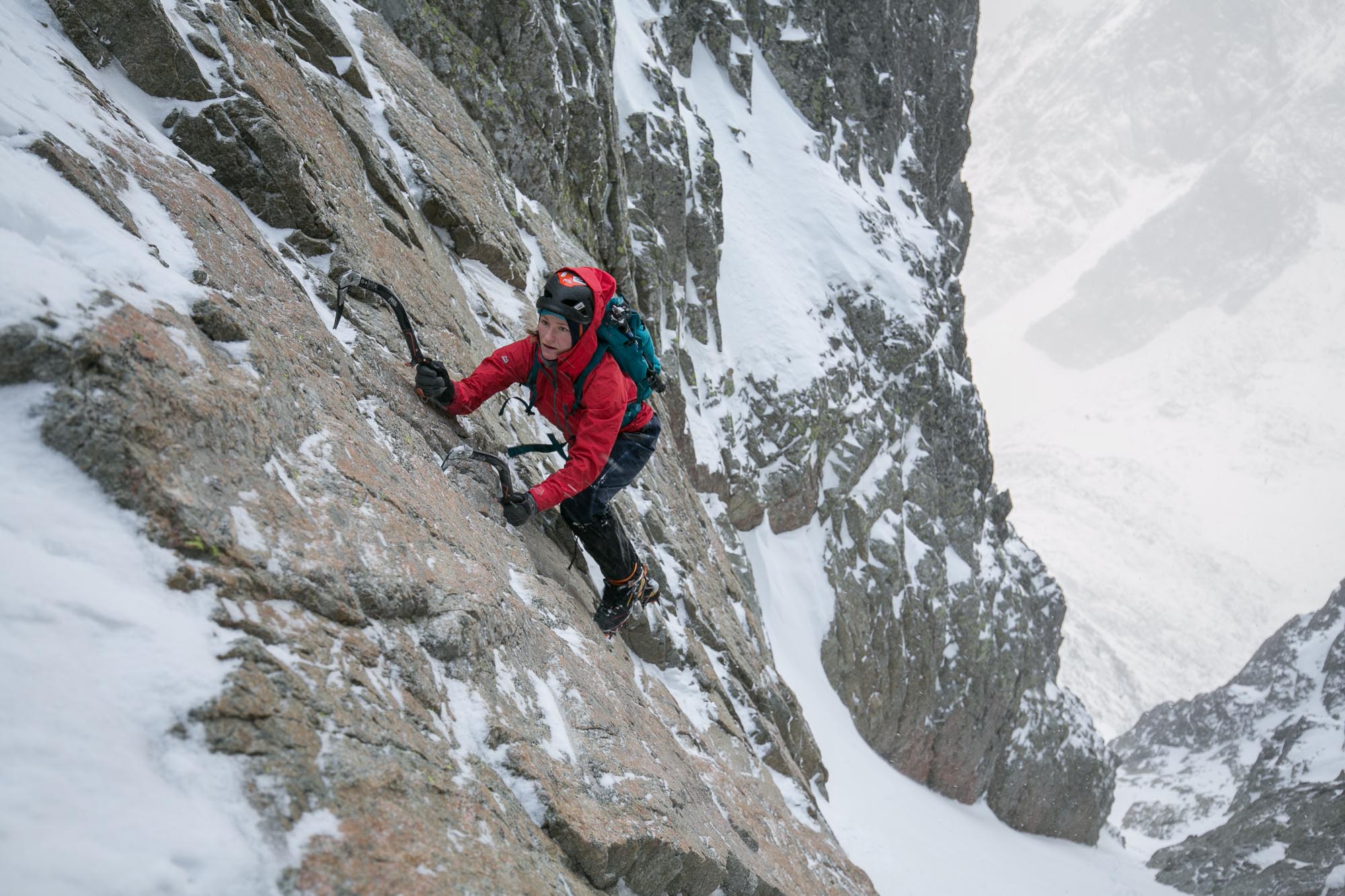
Anča, what would you like to know about Ella?
A: How are you doing at univerisity? Do you have the capacity to talk to anybody there, to deal with your classmates?
E: I have no problem with theoretical subjects, I like to learn. I usually deal with a little bit of complications when it comes to sports, which I have a lot of in my program (fitness trainer, note by the author). I find them hard to combine with my own training and also challenging because I have found that I am extremely untalented in sports other than climbing. Outside of my circle of friends, I’m pretty solitary and since I don’t spend that much time at uni, I don’t really feel the need to hang out with anyone, so I’m alone most of the time, which is pretty good for me.
A: I have one more question. The Olympics is an amazing goal, especially when you have the money to do it… But what’s so appealing to you about participating?
E: I’ve never really thought about it that way. Intuitively, I guess it makes sense to me as some sort of imaginary milestone in my career, maybe every athlete’s dream. At the moment it’s a big challenge for me, especially in terms of bouldering. I just have a dream that I think is difficult but achievable. And that dream is to be nominated there.
